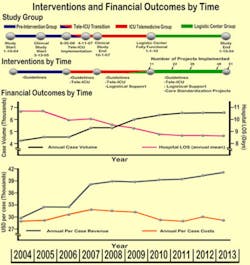Study: Tele-ICU programs can have significant positive financial impact
A new study recently accepted to be published in the journal CHEST demonstrates the benefits of intensive care unit (ICU) telemedicine. The study results establish that the Philips eICU Program with centralized bed management control increased case volume by up to 44% and improved contribution margins by up to 665%, or $52.7 million.
The study, entitled “ICU Telemedicine Program Financial Outcomes,” was authored by Craig M. Lilly, M.D., Professor of Medicine, Anesthesiology and Surgery, at the University of Massachusetts Medical School and Director of the eICU Program at UMass Memorial Medical Center. The study looked at more than 51,000 patients across seven adult ICUs on two campuses of an 834-bed academic medical center. While tele-ICUs have previously been associated with improving mortality rates and length of stay, this study is the first to address in depth the financial outcomes.
The study assessed three clinical models of ICU care over time:
- Traditional ICU care without telemedicine,
- Centralized tele-ICU care, and
- Tele-ICU care with a logistical center to improve ICU bed utilization.
Researchers compared case volume (number of patients cared for) and contribution margins (total case revenue minus direct costs, including costs of the eICU Program) for each model that revealed:
- An Intensive Care unit managed by a tele-ICU improved case volume by 21% over traditional models.
- A centralized tele-ICU model of care improved contribution margins by 376% ($37.7 million compared to $7.9 million) due to increased case volume, shorter lengths of stay (LOS), and higher case revenue relative to direct costs.
- A tele-ICU, when co-located with a logistical center, improved case volume 38% over traditional models.
- A tele-ICU with added logistical center and quality care standardization improved contribution margins by 665% ($60.6 million compared to $7.9 million).
- This care delivery model allowed recovery of the initial capital costs of the ICU telemedicine program in less than 3 months.
“An ICU bed costs approximately $2 million to build, and this study demonstrates a significant increase in case volume by better utilizing existing resources,” said Tom Zajac, Chief Executive Officer and Business Leader, Population Health Management, Philips, in a company statement. “This shift enables care for expanding populations without having to build and staff additional ICU beds, thus helping hospitals thrive in a value-based care environment.”
The Philips eICU Program is part of a suite of enterprise telemedicine solutions delivered by Philips to help address multiple cohorts within a population ranging from the highest acuity patients in the hospital, to discharge transition and chronic patient management, to prevention and healthy living for the general population.



